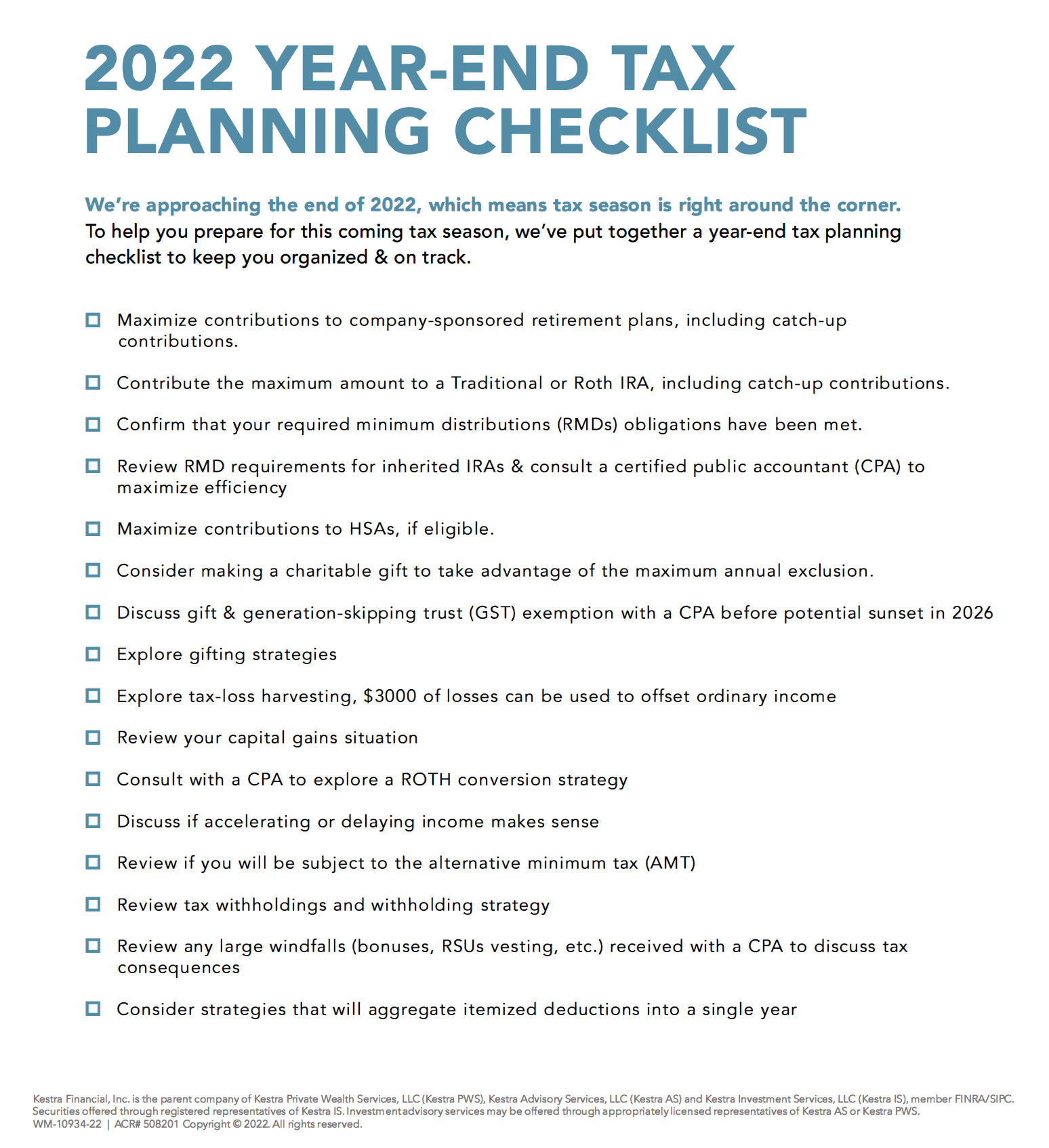We’re approaching the end of 2022, which means tax season is right around the corner. To help you prepare for this coming tax season, we’ve put together a year-end tax planning checklist to keep you organized & on track.
Continue readingPlanning for Tax Year End | Charitable Gifting
As the year draws to a close, you and your accountant may decide that itemizing deductions can be the right strategy for you.
Continue readingTax Strategies for Widows | What to Do When Your Spouse Dies
Widows often face a significant drop in income after the loss of their spouse, and the IRS offers a few important tax breaks that can help mitigate the loss and improve financial stability moving forward.
Continue readingHow & When to File a Life Insurance Claim
Filing a life insurance claim is a relatively simple process and should be done as soon as possible after the loss of your loved one. Knowing the process is underway may lift some of the financial stress during this time and help you prepare to make decisions about the road ahead.
Continue readingHow to Sell Your Business When It’s Time to Retire
You might be wondering what the best practices are for selling your business as you approach retirement. From the beginning stages of your business to the success and reputation it currently holds, you have worked hard to get to where you are. Now, you are ready to retire. Keep reading to learn some of our tips for selling your business when you are ready for retirement!
Plan Ahead
When it comes to planning your exit from the business you built from scratch, you need to make sure you plan ahead. Timing is everything, as is being prepared. It is beneficial to make sure your business would be ready to sell immediately, regardless of when you plan to retire. Once you are ready to enter retirement, having a proper transition strategy is vital. This includes creating a plan for informing your employees of the upcoming change, as well as a financial plan to ensure you are prepared to sell your business. You also need to be well-aware of each step of the selling process. Being knowledgeable in the selling process will increase your odds of making a successful business deal.
Know Your Business’s Worth
You need to make sure you are aware of what your business is actually worth. To do this, you should take a look at your assets, liabilities, and past profits. Rather than rely on what you think your business might be worth, it is best to stick to the facts and numbers to make that judgement. Having an adviser look over your business’s documents is a great way to stay organized, be prepared, and help decrease the potential for risk.
Consider Your Day-To-Day in Retirement
Shifting from working 50-70 hours a week as a business owner to being in retirement is a huge change. Prior to selling your business, you will want to make sure you have plans for your days in retirement. As you transition from working more than full-time, you might find yourself looking for things to do. Making a schedule and determining how you want to spend your days in retirement is key to making the most out of your days. However, there are plenty of retirees that like to live their new lives without a plan or schedule, so if that is keen to your beliefs, go for it!
Whether you want to sell your business immediately or in the future, there are several factors to keep in mind regarding the selling process and the transition in general. If you are passing your business onto the next generation in your family, or selling to someone else, having the correct tools, strategies, and mindset will guide you along the way.
When it comes to selling your business, we are here to help provide you with the right financial tools. If you’d like to know more about the services that we provide here at California Wealth Transitions, contact us today!
The Mega Back-Door Roth Strategy You Should Be Using
“I make too much money to contribute to a ROTH retirement account.”
How many times have we heard this as advisors? The good news is, no you don’t!
Many working individuals believe they are ineligible for ROTH accounts. What if I told you there are strategies to deposit funds into a ROTH every year regardless of your income?
It’s true. Many investors and professional advisors are not well versed in how to utilize the tremendous benefits of ROTH retirement accounts.
Please note, this is a guide to familiarize you with this strategy, if you’d like to learn more, you can speak with one of our financial advisors here.
Retirement Account Basics
Regular retirement accounts, IRA, SEP, 401k, 403b and Profit Sharing Pension plans all grow tax deferred. This means you do not pay taxes on the earnings in these retirement accounts until the funds are withdrawn, usually in retirement. In contrast, ROTH retirement accounts do not pay taxes on their earnings even when the funds are withdrawn in retirement. Money you contribute to a Roth truly becomes tax-free.
Chances are you have a 401k plan at work. You know you can put part of your salary in a retirement account before you pay tax on it, and that money grows tax-deferred. Your company usually matches a portion of what you put into the account as well. Since the money you put into these accounts do not incur any tax until you take it out, it’s a great way to save for retirement as your money grows more quickly than it would in a traditional investment account.
In addition, many plans also allow for Roth contributions, where the money is taxed before it goes into the 401k, but it then grows tax-free (assuming you meet several requirements). This may be a great strategy depending on your situation but many savers are reluctant to give up the tax deduction from the normal pre-tax contributions.
What Can You Contribute to a 401k?
Everyone wants to know how much they can contribute to a 401k. A simple Google search will tell you that the IRS does limit what you can put into these accounts. In 2020, the maximum you can contribute to a 401k plan is $19,500 (if you are over 50 you can add an additional $6,500 for a total of $26,000 per year). However, this is where most people’s understanding of their 401k plan ends.
If your knowledge ends here, know that you aren’t alone. There are so many subtle nuances in the different types of 401k plans and various advantages and drawbacks of each. This is why a customized financial plan is crucial; an advisor can help look at your overall situation with the specific type of plan you have, and make more informed decisions for you to efficiently plan for the future.
Enter the Mega Back-Door Roth Strategy
If you regularly max out those traditional 401k limits, you’ll want to pay attention here. What most people may not know is that the actual 2020 IRS limit for the total amount of Employee and Employer contributions is 100% of your income or $57,000 whichever is less (or $63,500 if you’re over age 50.)
Most people contribute the maximum deferral of $19,500 in each year, their company puts in an additional $5,000-10,000, and that’s it. For high earners, this usually results in excess money going into a savings account where it sits in cash and doesn’t grow, or into brokerage account each month where it’s at least growing, but that growth is subject to taxation, eating into the overall return. Financial planning is all about efficiency and making sure you are taking advantage of everything you can to maximize the growth of your money. So, after you’ve maxed your 401k contribution, where should you contribute next?
Most high earners contribute the maximum pre-tax contribution of $19,500 and stop there, even though the IRS allows you to put up to $57,000! This is a huge benefit that few people take advantage of simply because they were unaware. What if you could contribute an additional $20,000 to $30,000 per year and have those funds grow tax free? Would this be of benefit to you? Not all 401k plans allow these types of contributions but we can help you to determine if your plan has this option.
Even if your 401k plan does not have the appropriate features to allow for these additional deposits, there is one additional strategy to allow for annual ROTH IRA deposits up to $14,000 per year for a married couple. Are you a business owner? Consider setting up your solo plan to allow for these additional benefits.
Remember, both the ROTH 401k strategy and the ROTH IRA strategy are available regardless of your income.
If you are a high earner, and find yourself in a position of uncertainty around what accounts you should be utilizing for your savings, I urge you to contact one of our financial planners here.
Reducing Taxes For High Income Individuals
Yay! I love preparing taxes!
Wait, we’ve never heard anyone say that before. Except perhaps a CPA who really loves their job.
Why should you care about your taxes when it’s not even the tax season yet? For high earners, this is one area of your finances where you could significantly lose or save money if you have the right knowledge. The more money you earn, the more important your tax planning strategies become.
Tax law is complex, and constantly changing. Unless you’re that CPA we mentioned, you might have trouble figuring out exactly what applies to you and what strategies you could take advantage of to your benefit. A financial professional who has your best interests in mind could help you with tax planning – a financial strategy that starts long before the month of April.
California Wealth Transitions is not a CPA Firm; always consult with your CPA professional regarding the strategies discussed below.
These are situations that can make reducing your taxes a priority when it comes to managing your finances:
Do you have a higher-than-average salary?
Do you own a profitable business or are you self-employed?
Do you own real estate or have real estate you have inherited?
Do you have capital gains?
Pay attention if you want to reduce your income taxes.
Strategies for Reducing Income Taxes
Utilize the Right Retirement Accounts
How you save for retirement can significantly impact your income tax levels. Obviously you want to fully fund any retirement accounts offered by your employer, but if you are self-employed, set up the proper accounts. Anyone can set up a traditional IRA, deductible or non-deductible and you may also be eligible for a ROTH IRA depending on your level of income. If you’re self-employed, consider setting up your own SEP IRA or Solo 401k and contribute as your own employer. This is fully deductible as a business expense. Which one is right for you depends on your Modified Adjusted Growth Income (MAGI) and whether or not you have employees.
Many high income earners already have their basic retirement accounts covered. The question is what accounts to prioritize with your additional saving strategies to make every dollar as tax efficient as possible. Anticipate medical expenses and potentially long-term care expenses by utilizing a Health Savings Account (HSA). A financial professional can analyze pre-tax, backdoor strategies, and after-tax contributions to help you determine where to put your additional funds.
Know What You Own and What You Owe
This sounds like a basic idea, but high earning individuals tend to have many different streams of income and assets in many different forms from insurance policies to real estate. Do you have a statement of net worth that lists all your assets and their value? Is it up-to-date? This is really where tax planning starts. This can also impact your future estate, too – so it’s important!
Use Charitable Donations
Are you inclined to contribute to your favorite charities and gain the tax benefits? You can deduct up to 60 percent of your adjusted gross income each year for these gifts. And guess what…don’t think of charitable donations as cash only. You can donate stock and this could be an advantageous strategy for you especially if you have stocks that have increased in value since you purchased them.
Know What You’re Entitled to as a Business Owner or Real Estate Investor
Ever heard of the 199A deduction? This is a significant deduction that can make a big difference in what you owe. You can deduct up to 20% of the profits of your small business or your rental real estate, allowing sole proprietors, partnerships, and S corporations to reduce taxable income. These are tax deductions, not tax credits and there are certain limitations so check with your tax professional.
Consider Donor-Advised Funds (DAF)
Consider establishing a donor-advised fund, or DAF, which is essentially a personal charitable savings account. A donor can create a fund with contributions in many forms including cash, stock, or other assets and receive an immediate tax deduction for the gift.
To Defer, or Not to Defer … That Is the Question
Many high earners wonder if it’s better to pay taxes now or later. The truth is, if you’re in a top-tier tax bracket now, you most likely will be during your retirement. Deferring taxes now might be taxed at a higher rate in the future. However there are many caveats and nuances to tax deferral. Many high income individuals can benefit from tax-deferred annuity options and life insurance policies as savings vehicles. It really just depends on your individual situation. There is no “one-size-fits-all” answer to this question but it is worth discussing with your financial team.
Protect Your Estate
Do you want to keep as much of your wealth in the family as possible? Of course you do. Consider a Grantor Retained Annuity Trust (GRAT), which can allow you to pass your wealth to the next generation without a significant tax impact. We’ll cover more on protecting your estate to transfer your wealth in our upcoming blog.
Tax planning encompasses a lot of fine tuned strategies that can hold big impact. Our final thoughts on taxes for high earners?
Don’t make panicked decisions at the end of the year in an effort to reduce your taxable income. This is rarely a good move. Consult a professional and start early – get your tax strategy together before the end of the year!
Remember that the IRS isn’t likely to tell you that you’ve overpaid. Perhaps you have your taxes pretty well in line. But have you explored ALL of the options? Trust a professional who has resources at their disposal to get all the pieces of your financial life working together.








